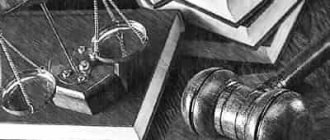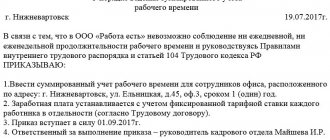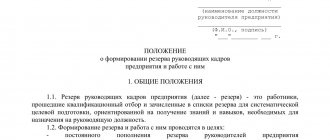Receipt order M 4
Despite the entry into force of Law No. 402-FZ “On Accounting,” forms of primary documentation that were previously considered unified and mandatory for use remain in demand to this day.
One of these forms is the M4 receipt order (hereinafter referred to as the M-4 order). It is actively used by small businesses to account for received materials. Moreover, Law No. 402-FZ itself does not prohibit doing this.
What kind of document is this?
and a sample of filling out a receipt order M4.
First of all, the form of this receipt order was approved by the State Statistics Committee of the Russian Federation in Resolution No. 71a of October 30, 1997. Today it is not mandatory for use, but its use is not prohibited by law.
In order to safely use the specified document for accounting purposes, you only need to approve it in the Accounting Policy.
This document formalizes the registration of materials that arrived at the enterprise from suppliers or from processing.
It is worth noting that this form is used only when receiving materials for which there are no claims to their qualitative or quantitative content, i.e.
if the actual data corresponds to the documents from the supplier. This is stated in paragraph 49 of the Methodological Instructions of the Ministry of Finance of the Russian Federation (order No. 119n dated December 28, 2001).
Order M-4 serves as the basis for warehouse, tax and accounting of materials. In particular, in paragraph
1 of Article 9 of Law No. 402-FZ states that all facts of economic activity must be documented in primary documents. Thus, the receipt order M4 serves as confirmation of the acceptance (!) of assets for accounting .
It is filled out based on the actual amount of material assets accepted and on the basis of the primary documentation accompanying them.
In addition, the preparation of this document performs another function - it serves as recognition of the supply of materials without claims against the supplier (processor).
Application of this order
As stated earlier, receipt order M4 is used to register materials, which include:
- various raw materials;
- purchased semi-finished products;
- materials (basic and auxiliary);
- components and spare parts;
- fuel and containers;
- construction materials, and other similar assets, which, on the basis of PBU No. 5/01 “Accounting for inventories”, are recognized as materials.
However, form M-4 is used not only when materials are received by an enterprise from a supplier (i.e., under sales and purchase agreements, exchange, and for other reasons) or from processing.
With the help of such a receipt order assets are registered that:
- received as a contribution from the founders to the authorized capital;
- joined the organization free of charge;
- purchased by an accountable person;
- manufactured in-house;
- identified during the audit as surplus, etc.
In other words, for any reason for the receipt of materials, an M-4 order must always be issued! But only if there are no discrepancies in their quality and quantity.
As for the application of this document at enterprises, it can be used by legal entities of any form of ownership and legal form, including budgetary structures. But entrepreneurs decide for themselves whether to use the M-4 order in accounting or not.
The fact is that Resolution of the State Statistics Committee of the Russian Federation No. 71a dated October 30, 1997. applies only to organizations. This normative act does not apply to entrepreneurs.
But if they decide to use the document to simplify tax accounting or for warehouse accounting purposes, then they should approve the use of the specified form in the Order.
If you have not yet registered an organization, then the easiest way is
This can be done using online services that will help you generate all the necessary documents for free:
- for individual entrepreneur registration
- LLC registration
If you already have an organization and you are thinking about how to simplify and automate accounting and reporting, then the following online services will come to the rescue, which will completely replace an accountant in your company and save a lot of money and time. All reporting is generated automatically, signed electronically and sent automatically online.
- Accounting for individual entrepreneurs
- Bookkeeping for LLC
It is ideal for individual entrepreneurs or LLCs on the simplified tax system, UTII, PSN, TS, OSNO. Everything happens in a few clicks, without queues and stress. Try it and you will be surprised
how easy it has become!
General provisions for registration
First of all, the specified document is filled out in one copy by the person responsible for receiving materials and then transferred to the accounting department for further accounting of assets along with the documents accompanying them. And for the purposes of warehouse accounting, an accounting card is opened for received materials, which reflects all incoming and outgoing transactions for this asset.
The documents received by the accounting department are checked and if there are no disagreements, the appropriate entries :
D account 10 “Materials” (if accounting is carried out directly through this account) To account. 71 “Settlements with accountable persons”, account 60 “Settlements with suppliers”, etc. – depending on the reason for the receipt of assets.
is signed by the person accepting the materials and the person handing them over.
The document is drawn up on the day the materials are received or within other deadlines that are provided directly at the enterprise, but no later than the deadlines established by current legislation.
In case of receipt of homogeneous shipments that arrive from the same supplier several times during the day, it is allowed to draw up a general receipt order M-4 for all such deliveries that took place on that day. But at the same time, for each separately received batch of such materials, notes are made on the back of the M-4 form.
At the end of the day, these entries are all checked, counted, and a total is derived from them, which is now entered into the receipt order.
It is worth noting that instead of an M4 order, a stamp may be affixed . It is placed on any document accompanying the materials (on an invoice, invoice, etc.) and is equal in its force and consequences for the accounting process to a receipt order.
However, such a stamp can replace an M4 order only on the condition that:
- it contains all the details of the receipt order;
- all these details must be filled out;
- the stamp must bear the next number of the M-4 form.
At the same time, current legislation does not prohibit the simultaneous use of both such a stamp and an M-4 order at an enterprise.
If during the delivery of materials discrepancies with the supplier’s data were found, then instead of a receipt order, an act of form M-7 is drawn up.
Step-by-step filling instructions
Upon receipt of materials, the materially responsible person (hereinafter referred to as the storekeeper) issues a receipt order, indicating:
- serial number of the form and the date of its preparation;
- name of the organization and department receiving the materials;
- Next, indicate the name of the supplier and, if available, the insurance company. The insurance company is indicated only when the cargo is insured. Otherwise, either a dash is placed in this column, or it remains empty;
- As for encodings - “Operation code”, “Supplier code”, etc. - these columns are rarely filled in by representatives of small businesses, since they usually do not approve the internal classifier of such codes. Therefore, in these columns they either make a dash or leave them empty;
- then the storekeeper enters the number of the accompanying document in the column of the same name. The data is taken from the invoice.
As soon as filling out this tabular part of the order is completed, the storekeeper proceeds to the descriptive part :
- the exact name of the received materials, its grade and other characteristics are taken from the accompanying documents - certificates, etc.
- the item number is indicated either by the accounting department based on analytical accounting data, or by the storekeeper - according to warehouse accounting data;
- the code and name of the unit of measurement of materials can be taken from the All-Russian Classifier of Units of Measurement. And the units themselves are initially indicated in the invoices for materials;
- The quantity of materials received is recorded in fact and simultaneously according to the supplier’s documents. The indicated numbers must match;
- all cost indicators are also taken from the accompanying documents. First, the price per unit is indicated, excluding VAT, and then the cost of the entire delivery is indicated, also excluding VAT. Further, VAT on the entire delivery and the total cost of the shipment together with tax are indicated separately;
- in the column “Passport number” the details of this document are written only when delivering materials that contain stones or precious metals. Such a delivery is usually accompanied by a passport;
- in the column “Order number according to the warehouse card file” the number of the M17 accounting card, which is registered for this type of materials, is indicated.
All these columns are filled in in one document for several types of materials, if they were received by the enterprise under one invoice. That is why at the end, on the reverse side of the M4 receipt order, the total is summarized only by cost indicators.
If materials were received using different invoices, then a separate receipt order is created for each delivery.
The exception is delivery made during the day, of homogeneous goods and from one supplier. In this case, a general receipt order is issued.
As for such columns as “Corresponding account” and “Payment document number”, they are usually filled out by the accounting department based on its data.
The order is signed by the storekeeper and by the one who brought the materials from the supplier, from processing, or hands them over to the warehouse upon receipt for other reasons.
Step-by-step instructions for registering a receipt order in 1C are presented in the following video lesson:
Source: https://www.DelaSuper.ru/view_post.php?id=10956
What do you need to know? ↑
Federal Law No. 129 of November 21, 1996, in Article 9, determines that all business transactions performed by an economic entity must be accompanied by the preparation of primary documentation.
When an organization purchases materials necessary for the manufacture of products, only a receipt order can be used as primary documentation.
As for accepting goods, the attitude of the regulatory authorities is not so strict. When putting commodity values on the balance sheet, it is permissible to be guided by invoices from suppliers if they have all the necessary stamps on them.
But if the company buying goods is engaged in other activities besides trading, then the creation of receipt orders is a strict requirement.
Basic Concepts
A receipt order is a primary document drawn up when an economic entity acquires material assets.
In this case, the receipt order acts as an argument for making a record of the transfer of materials for warehouse storage in the materials warehouse card M-17.
A standard form M-4 is provided for this order. It is issued at the time of receipt of material objects.
Receipt order M-4 is a list of commodity values or material objects purchased from the supplying organization and received by the buyer after completing all the processes provided for by the contract.
The form of the order is determined by the responsible person or management. But if the document drawn up does not correspond to the accepted basic model, then it may be declared invalid.
What is it needed for
Registration of an M-4 order is necessary for warehouse accounting of operations for the receipt of materials, marketable products or other valuables.
This document is also drawn up upon receipt of raw materials and semi-finished products for production workshops and divisions of the organization. This document indicates the actual volume of all accepted accounting items.
In case of multiple deliveries of the same type of materials or goods during the day, a single order is allowed.
It is advisable to use a receipt order form M-4 when it is impossible to use other forms of accounting as receipt documentation.
You can issue a receipt for several types of materials, if they are supplied under one invoice. Keeping records of units of precious metals and stones deserves special attention.
The receipt order must display not only the number of valuables; the registration number of the technical passport for each type of metal or stone must be written in a special column.
Legal regulation
Federal Law No. 129 of November 21, 1996 “On Accounting” in Article 9 includes a requirement for the need to document all management transactions with primary documentation.
Resolution of the State Statistics Committee of the Russian Federation No. 71a dated October 30, 1997 established a primary document for the posting of enrolled materials. Such a document is the form of receipt order M-4.
According to clause 49 of the “Methodological guidelines for accounting of inventories”, ratified by Order of the Ministry of Finance of the Russian Federation No. 119n dated December 28, 2001, an M-4 order accompanies any crediting of materials.
Organizations that, in addition to trade, are engaged in other types of activities must receive and receive goods in the same way as the procedure for registering material objects.
This is provided for in paragraph 224 of the above Guidelines. It is important that this procedure should not be followed by entities conducting only trading activities.
According to Article 9 of Federal Law No. 129, the receipt order M-4 specifies the date of receipt, the number of material assets and other essential details.
If receipt orders are not used in accounting, tax authorities have the right to make claims regarding shortcomings in the primary documentation and cancel the deduction of input VAT.
According to clause 3 of Article 120 of the Tax Code of the Russian Federation, failure to draw up primary documentation is considered a gross violation of the standards for accounting for income/expenses and taxable items.
The fine under this standard varies from five to fifteen thousand rubles. If the tax base is understated, the amount of penalties is equal to ten percent of the amount of unpaid tax, but not less than fifteen thousand rubles.
If the material assets received are capitalized without generating a receipt order, this may be taken into account as an understatement of the tax base.
For any business transaction, it is necessary to draw up primary documents with the presence of mandatory details. Only after proper preparation can the documents be accepted for accounting, and the business operation reflected on the accounting accounts.
From which it follows that the receipt of material assets on the organization’s balance sheet is reflected in the accounts only after drawing up the M-4 receipt order.
After this, the entity has the right to use the deduction of input VAT if other conditions for offset are met.
Receipt order example of filling m4
The passport number is indicated if inventory items have this accompanying document (for example, jewelry). Lastly, the card number according to the warehouse card index is entered into the table.
The remaining unfilled lines must be crossed out (in the form of the letter Z or crosswise).
Filling out the reverse side of the M-4 form. The reverse side of the document summarizes the receipt: the total quantity of goods received, its total cost without VAT, the amount of VAT and the cost with VAT. There is no need to decipher the amounts in writing.
Finally, the receipt order must be signed by the direct recipient of the goods (in this case, the storekeeper) and the supplier’s representative (in this case, the forwarder) with a mandatory decoding. There is no need to certify the order with a seal, because
Receipt order (form M-4) + sample filling
If there is no such classifier, then a dash is placed in this column. Insurance Company. The name of the company that insured the cargo is indicated. If the cargo was not insured, then a dash is placed. Document number (accompanying).
The number of the document on which the materials were received is indicated - invoice or consignment note. Document number (payment). The number of the document for which the received materials were paid is indicated - a payment order or payment request. Price (column 7). The cost per unit of material is indicated excluding VAT. VAT amount (column 9).
Receipt order in form M-4
M-8. The financially responsible person enters the following information into the form:
- Order number;
- Name of the organization and its OKPO;
- The date of drawing up the receipt order;
- Operation type code, if such a code exists;
- Name of the warehouse where the materials are received;
- Supplier name and code;
- Account number to which the inventory items are accounted for;
- Number of the accompanying and payment document.
Information about material assets is entered in the table below:
- Brand, grade, size;
- Nomenclature number;
- Unit of measurement;
- Quantity of materials according to accompanying documents (delivery note) and actually received;
- Unit price, VAT and amount including VAT;
- Passport ID;
- Number according to the card index in the warehouse.
At the end of the day, the total number of valuables received at the warehouse is calculated.
Receipt order m-4
Account: account number for accounting for materials, as well as sub-account number. Number of the accompanying and payment document. The table of form M-4 is filled in with the following data: 1 – name of material assets. 2 – number according to the nomenclature.
3.4 – information about the unit of measurement. 5 – quantity that should be received according to the supplier’s documents. 6 – quantity that actually arrived. 7 – price per unit. 8 – amount excluding VAT. 9 – tax is allocated separately. 10 – total amount including tax.
11 – passport number, if available. 12 – number according to the card index. The M-4 receipt order must contain the following signatures: the person receiving materials to the warehouse (for example, a storekeeper), the person who delivered the valuables (for example, a forwarder).
and a sample receipt order form M-4 – link.
FILESDownload a blank form for a receipt order using form M-4 .doc filling out a receipt order using form M-4 .doc Basic rules for filling out form M-4 Since 2013, this form is not strictly mandatory for use, however, it is still widely used used in enterprises and organizations.
The receipt order has two sides and contains all the necessary information regarding the supplier, consumer and the product itself: its name, grade, size, quantity, cost, etc. (it should be noted that some cells can be left empty).
If the inventory contains precious metals or stones, then this document must indicate information from the accompanying technical passport.
When filling out an order, you should avoid mistakes and omissions, and if there are any inaccuracies, it is better to fill out a new form.
Registration and filling out a receipt order (form M-4)
M-4
- The receipt order for the receipt of inventory items has its own serial number and date of preparation.
- “Organization” - fill in the name of the enterprise, indicating the legal address and contact phone number.
- “Structural unit” is a department of the enterprise that received inventory items.
- The tabular section reflects:
- Date of receipt of inventory items;
- Operation type code;
- Warehouse name;
- The name and code of the supplier from the classifier of supplier codes (if this directory is not maintained by the organization, then a dash is placed in the “Code” column);
- Insurance company, subject to cargo insurance (if inventory items were not insured, a dash is added);
- Corresponding accounts for accounting and analytical accounting;
- Numbers of accompanying and payment documents.
5.
Receipt order form M-4
Fill out and M-4 (Sign out documents without errors and 2 times faster by automatically filling out documents in the Class365 program) View a sample of filling out View the full catalog of forms How to simplify the work with documents and keep records easily and effortlessly more details Special program for small businesses Class365 - online program for everyone:
- 50 current document forms
- Trade and warehouse accounting
- CRM system for working with clients
- Bank and Cashier
- Integration with online stores
- Built-in mail and SMS sending
- One-click reports
Free for one user See how Class365 worksEnter the demo version How to correctly fill out a receipt order A receipt order can be issued for several items of materials at once if they were received under one invoice.
Your account has been created!
Source: https://juristufa.ru/2018/04/19/prihodnyj-order-primer-zapolneniya-m4/
How to fill out a receipt order? Basic Steps
Each order, which records the receipt of inventory items at the enterprise, must be numbered, and a date must be put on the document. The following main filling stages can be listed:
- Indication of the full name of the enterprise. His legal name is also stated. address and necessary contact information.
- The structural unit of the organization to which material assets are transferred is indicated.
- In the table you must enter the date of the transaction code, the name of the inventory, and the name of the supplier. If the company uses supplier coding, the corresponding code is indicated, and if not, a dash is added.
- The insurance company is indicated if the material assets were insured during the transfer. If this has not been done, you need to put a dash in the column.
- Next, accounts for accounting are written down, as well as details of accompanying documents.
After this, you need to fill out separate fields that contain detailed information about the product. The name of material assets, item number, unit of measurement, quantity, cost excluding VAT, and the amount of VAT are indicated. If materials of high value are transferred, for example, precious stones, the data of the product passport must be indicated. In column 12 you must enter the serial number according to the warehouse card file.
After the table in the order, the total amounts are indicated; in empty columns you need to put dashes. The M4 order must bear the signatures of the supplier’s representative who provides the materials and the receiving financially responsible employee. After registration, the order is redirected to the accounting department for accounting and control.
Filling out the M-4 receipt order allows you to ensure control of all incoming materials, semi-finished products and other material assets, as well as control cooperation with suppliers. Maintaining documentation in accordance with all the rules allows you to avoid the loss of material assets or excessive payments to the supplier.
Situation: The LLC is on the general taxation system, the main activity is wholesale trade in construction materials. When goods arrive, we issue a receipt order in form M-4. Question: 1) who should sign the documents in the accepted and handed over line if the goods were brought to us by the supplier on your own transport at your own expense, but received the goods in our warehouse, the manager. warehouse? 2) who should sign the documents in the line accepted and handed over, if the goods were delivered by a transport company hired by us, at our expense, and the manager received the goods in our warehouse. warehouse?
1) If the goods were brought to you by the supplier on his own transport at his own expense, then the supplier’s driver (forwarder) signs the line “delivered”; the line “accepted” is signed by the manager. warehouse
2) If the goods were delivered by the transport company you hired, then the driver of the transport company signs the line “handed over”, the manager signs the line “accepted”. warehouse
The receipt order must be signed by the persons who hand over and accept the materials. To reduce paperwork, a receipt order can be omitted. It can be replaced with a stamp (sample below). Place it directly on the supplier's document. For example, on an invoice.
Andrey Kizimov,
Deputy Director of the Department of Tax and Customs Tariff Policy of the Ministry of Finance of Russia
How to register and reflect the receipt of materials in accounting
The chief accountant advises:
To reduce paperwork, a receipt order may not be issued. It can be replaced with a stamp. Place it directly on the supplier's document. For example, on an invoice.
More on the topic
How to protect yourself. Inspectors charged expenses due to signature on invoice
Argument No. 3.
Another argument could be the second signature on receipt orders in form M-4. There are two entries in the document - passed and accepted. But the resolution of the State Statistics Committee of Russia dated October 30, 1997 No. 71a does not clearly define how to fill out these lines. In fact, this is not a two-sided document, but an internal document, since it is drawn up in one copy. But both a stranger and an employee can sign the document. This will confirm that the intermediary or courier who received the goods from the supplier has handed them over to the company.
The short designation M-4 hides the receipt order form. This document refers to primary accounting documents and is issued when the enterprise’s warehouse receives any products from suppliers that must be received.
Receipt order in form M-4: form and sample filling
Among the primary reporting documents that certify the receipt of goods and raw materials at the organization's warehouse, the receipt order is the main one. The M-4 document form is established by the State Statistics Committee, therefore documentation is maintained only according to the approved form, which is presented below.
Form M-4 receipt order (word)
Sample of filling out a receipt order M-4 (word)
2020 sample
This year, the form of the document has not changed at all compared to the previous year. An order in form M-4 is drawn up as shown in the figure:
- The document number is written (in the center).
- Then - the full name of the organization, as well as the structural unit.
- The corresponding OKPO code is written in the right corner.
- In the first table, all columns are filled in - date of arrival, code, warehouse number, information about the supplier and insurance company, the corresponding account, as well as the numbers of the accompanying and payment documents.
- The main table indicates all the data about the arrived product - name, how many pieces, amount with and without VAT, total amount.
- All empty lines are crossed out.
A detailed explanation of all columns is presented in the table.
| column name | filling rules |
| name of the company or structural unit | The full name of the company or individual entrepreneur at whose disposal the relevant goods or raw materials for production was received is indicated. It is important to indicate the name in full, as it appears in official documents, for example Limited Liability Company “Proxy” or Individual Entrepreneur Alexander Pavlovich Bondarenko. In the structural unit column we mean the internal department of the enterprise. Usually it is written as “warehouse”. |
| supplier information | The name of the supplier is written here as it is specified in the contract (abbreviations IP, LLC, etc. are allowed). Document numbers are transferred from the payment and accompanying document respectively. |
| account information | Details of the bank account on the basis of which funds are credited are provided. Accounting entries are also made for the same account. |
| information about goods received from the supplier | Basic information is a complete list of information about goods, raw materials, semi-finished products and other valuables that were received from the supplier. Enter the number, full name, parameters, grade, brand, in what units the goods are measured, and the quantity in these units. The cost per unit is indicated, which must exactly correspond to the contract. The cost without VAT is given, then the VAT itself for each product, after which the total cost is filled in. It is the receiving party that sends it to the supplier. |
| code by type of operation | This option does not always fit. It should be recorded only if the company has installed a special classifier that takes into account various business transactions. If this document is not maintained, it is permissible to simply put a dash. |
| supplier code | Here the situation is the opposite. This code is affixed in accordance with the classification of business transactions adopted by the organization that supplied the goods or raw materials. If such a document is not maintained, a dash is again added. |
| Insurance Company | In some cases, the supplier or receiving party insures the goods against various risks. Accordingly, in this case you need to write the full name of the insurance company, as it is indicated in the contract. If the goods were not insured, a dash is placed. |
| number of the accompanying document | In most cases, the accompanying document is the invoice for the goods. This can be either the actual invoice for the goods, or a consignment note, which, among other things, provides information about the delivery route. In this column you only need to enter the invoice number |
| payment document number | The document number confirming the fact of payment is indicated here. This is an order or requirement. |
| column 12 | The card number is entered in accordance with how it is described in form M-17 |
If precious metals and/or products made from them are being accepted, column 11 is also filled out in the table, which indicates the number of the technical passport for each unit of goods.
The form and example of a completed receipt order are presented below.
NOTE. The accountant is not required to print out the receipt order. It’s enough to simply compose it in the 1C program. You can do without a paper form of the document if acceptance and posting are formalized on the invoice or invoice of the supplier of the goods. A stamp is placed and its details are filled in, which are considered an analogue of the receipt.
Purpose
Issued to confirm all transactions related to the receipt of goods from the supplier, as well as materials subsequently used for the production of products. In accounting, it is determined that it is the receipt order that represents the main document, which reflects the fact of acceptance of goods for subsequent warehouse accounting.
At the same time, a receipt is issued in all cases when they receive:
- the actual product;
- raw materials for production processes;
- semi-finished products for further sale and/or use in production, as well as food preparation.
Along with this appointment, the receiver plays a big role in the case of registering goods for storage in a warehouse. It is on the basis of the data in this document that a material storage record card is compiled (form M-17 is approved by law).
Moreover, if goods or raw materials, technical materials are purchased, which will later be used for production purposes, then the receipt order is the only primary reporting document that confirms the fact of receipt.
Registration deadlines
There are cases of large volume deliveries of goods during the day. The legislation allows you to draw up one receipt document, and enter all goods into it as they are received until the end of the working day. However, these must be homogeneous goods (for example, raw materials or semi-finished products of a certain group).
NOTE. The order is issued only on the day the goods or raw materials arrive. Accordingly, it must be drawn up upon receipt before the end of working hours.
Thus, an order must be drawn up only in the event of further use of goods and raw materials for the production of new products . And if the company is engaged in their sale, then it is enough to simply use the invoices for the goods and affix the organization’s stamp.
Who can sign the document
Certification of the order with the signature of an authorized person is a mandatory requirement. Moreover, the signature of the financially responsible employee who has the right to accept the goods is affixed. If such a person is absent, the authority is transferred to another employee. In case of a long absence (business trip, vacation, etc.), a power of attorney may be drawn up to perform such actions.
The document is considered finally accepted after the signature is placed. Accordingly, no corrections can be made to it after this. And at the time of signing, all empty columns must be crossed out. Even small amendments will lead to the order becoming invalid, so a new one will have to be drawn up.
After this, the operation is reflected in the accounting documents, and the document itself is sent to the archive and is provided only at the request of the inspectors.
link:
Loading…
Source: https://2ann.ru/blank-prixodnogo-ordera-forma-m-4/
/ Economic law / Registration of receipt order m 4 example of filling
The passport number is indicated if inventory items have this accompanying document (for example, jewelry). Lastly, the card number according to the warehouse card index is entered into the table.
The remaining unfilled lines must be crossed out (in the form of the letter Z or crosswise).
Filling out the reverse side of the M-4 form. The reverse side of the document summarizes the receipt: the total quantity of goods received, its total cost without VAT, the amount of VAT and the cost with VAT. There is no need to decipher the amounts in writing.
Finally, the receipt order must be signed by the direct recipient of the goods (in this case, the storekeeper) and the supplier’s representative (in this case, the forwarder) with a mandatory decoding. There is no need to certify the order with a seal, because
Attention
FILESDownload a blank form for a receipt order using form M-4 .doc filling out a receipt order using form M-4 .doc Basic rules for filling out form M-4 Since 2013, this form is not strictly mandatory for use, however, it is still widely used used in enterprises and organizations.
The receipt order has two sides and contains all the necessary information regarding the supplier, consumer and the product itself: its name, grade, size, quantity, cost, etc. (it should be noted that some cells can be left empty).
If the inventory contains precious metals or stones, then this document must indicate information from the accompanying technical passport.
When filling out an order, you should avoid mistakes and omissions, and if there are any inaccuracies, it is better to fill out a new form.
The procedure for generating a receipt order m4
According to the rules, the form can be filled out either by hand or on a computer, but in any case, the document must necessarily contain “live” signatures of the supplier’s representative and the consumer.
After registration, the number of the receipt order must be registered in the materials accounting card and transferred for storage to the accounting department of the enterprise, where it, like other primary documents, must be stored for at least five years.
The document is issued exactly on the day the goods are received and reflects the actual receipt. A receipt order is drawn up in one copy, and if there are several deliveries from the same supplier within one day, they can all be entered into one document.
Instructions for filling out a receipt order It is impossible to say that this type of document may cause some difficulties when filling out, since it has a completely simple and understandable form.
Online magazine for accountants
This form can be used in the process of business activities. Or, guided by the sample, you can develop your own form of the document. The main thing is that the form you developed yourself contains all the necessary details.
You can see how to correctly fill out the M-4 receipt order here. It is important to fill out the order correctly. An improperly drawn up document will be considered invalid. This means that there are no primary accounting documents.
Who signs the order The finished receipt order M-4 must be certified by a signature. Only the person who is financially responsible and who directly accepts the materials received by the organization has the right to sign.
Once the order is signed, it is not permissible to make changes to the items on the form. A document with corrections will be considered invalid.









